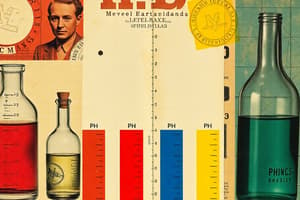Podcast
Questions and Answers
What is the primary characteristic property of an indicator?
What is the primary characteristic property of an indicator?
- It changes color with changes in pH. (correct)
- It can only be used with strong acids.
- It remains unchanged during a reaction.
- It reacts with solutes to form new compounds.
Which factor is crucial when choosing an appropriate indicator for a reaction?
Which factor is crucial when choosing an appropriate indicator for a reaction?
- The molecular weight of the reactants
- The temperature of the solution
- The final pH of the resulting solution (correct)
- The volume of reactants used
What does the formation of H₃O⁺ indicate in a reaction between a strong acid and a weak base?
What does the formation of H₃O⁺ indicate in a reaction between a strong acid and a weak base?
- The solution becomes neutral.
- The solution remains basic.
- The solution becomes acidic. (correct)
- The solution has no changes in pH.
What happens to the pH after the reaction between HCl and NH₄OH is complete?
What happens to the pH after the reaction between HCl and NH₄OH is complete?
Which statement about the ionization of salts in a solution is true?
Which statement about the ionization of salts in a solution is true?
Flashcards
Indicator
Indicator
A chemical substance that changes color depending on the acidity or alkalinity (pH) of a solution.
pH
pH
The measure of acidity or alkalinity of a solution, ranging from 0 to 14.
Acid
Acid
A substance that releases hydrogen ions (H+) when dissolved in water, making the solution acidic.
Base
Base
Signup and view all the flashcards
Neutralization
Neutralization
Signup and view all the flashcards
Study Notes
Indicator Properties
- An indicator is a chemical substance that is either a weak acid or a weak base
- Indicators typically have complex structures
- The defining characteristic of an indicator is that its color changes with the pH of the resulting solution
Salt Ionization and Reaction
- The salt in the resulting solution can ionize; these ions can react with water.
- If this reaction occurs, a new substance is formed.
- The new substance can change the pH of the solution; this indicates the reaction is complete.
Strong Acid and Strong Base Reaction
- For a strong acid-strong base reaction, the pH will remain the same once the reaction is complete. An example is HCl + NaOH → NaCl + H₂O
- This is because the result of the dissociation of the salt ions doesn't affect the solution's pH
Strong Acid and Weak Base Reaction
- HCl + NH₄OH → NH₄Cl + H₂O
- A new substance, H₃O⁺ is formed, making the solution acidic. This changes the pH.
- Therefore, when the reaction is complete the pH of the medium changes
- Indicators like methyl red or similar can be used in these scenarios.
Studying That Suits You
Use AI to generate personalized quizzes and flashcards to suit your learning preferences.
Description
Explore the properties of indicators and their role in acid-base reactions. Learn how strong and weak acids interact with bases and how pH changes throughout these reactions. This quiz will test your understanding of chemical interactions and their outcomes.




